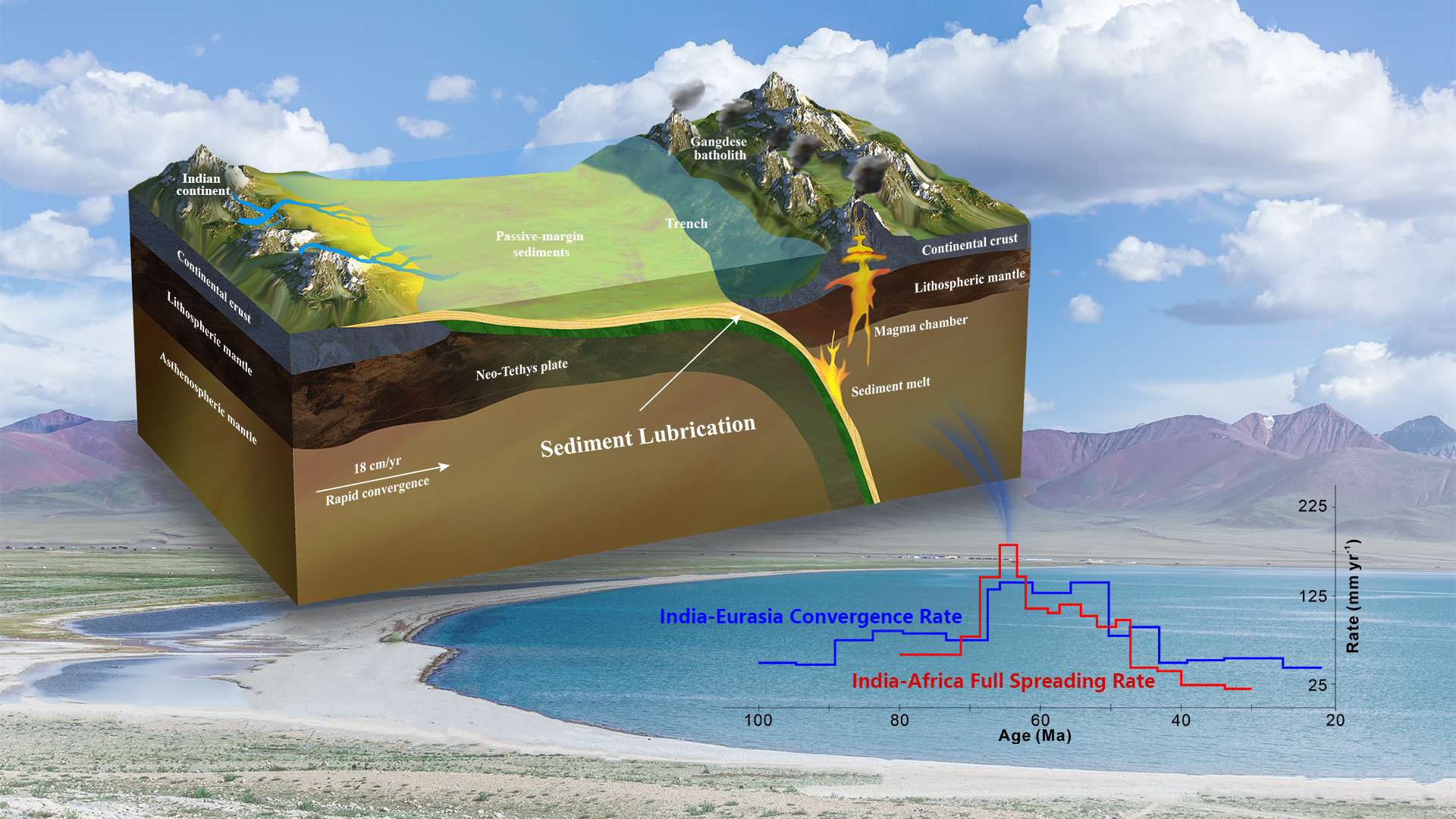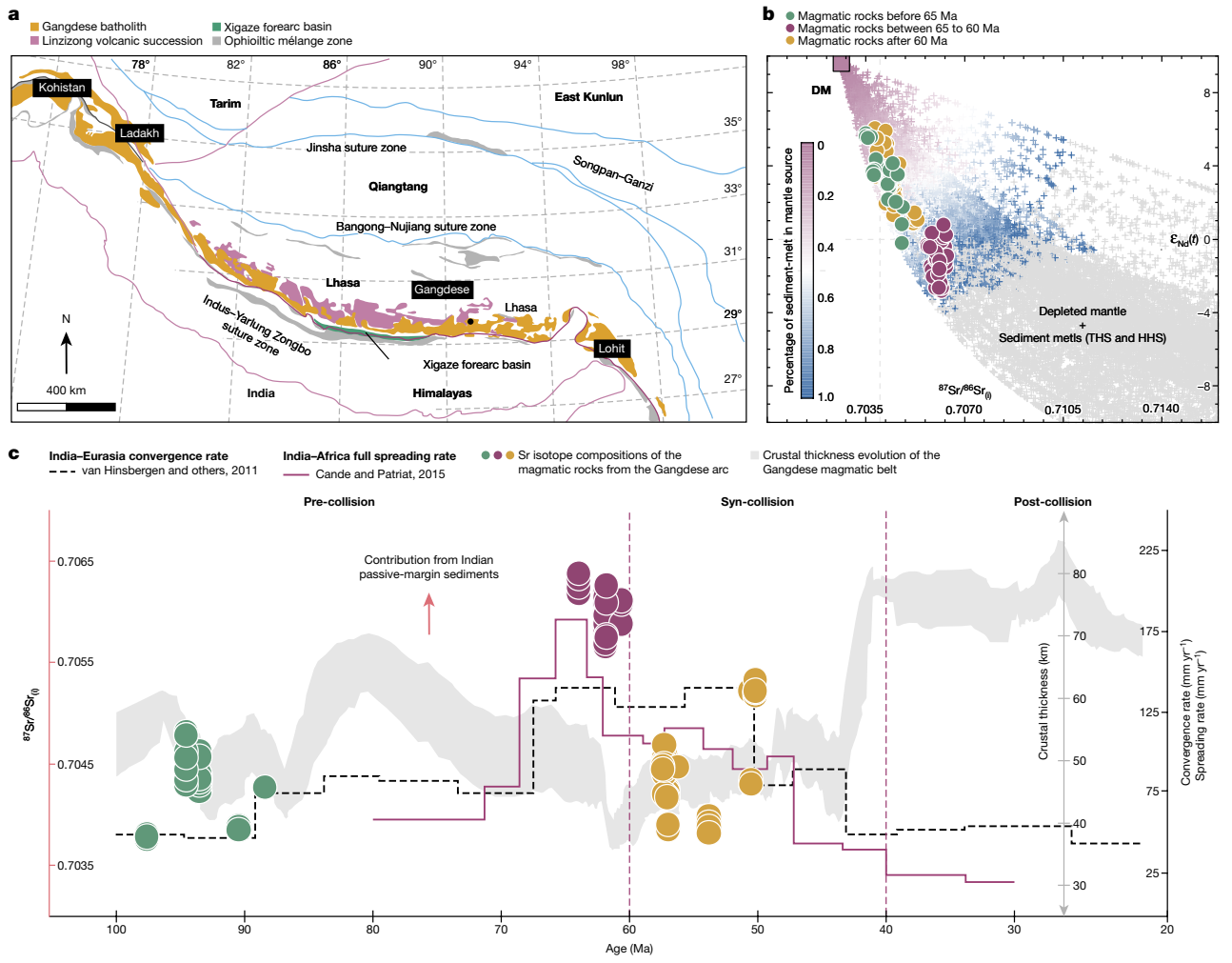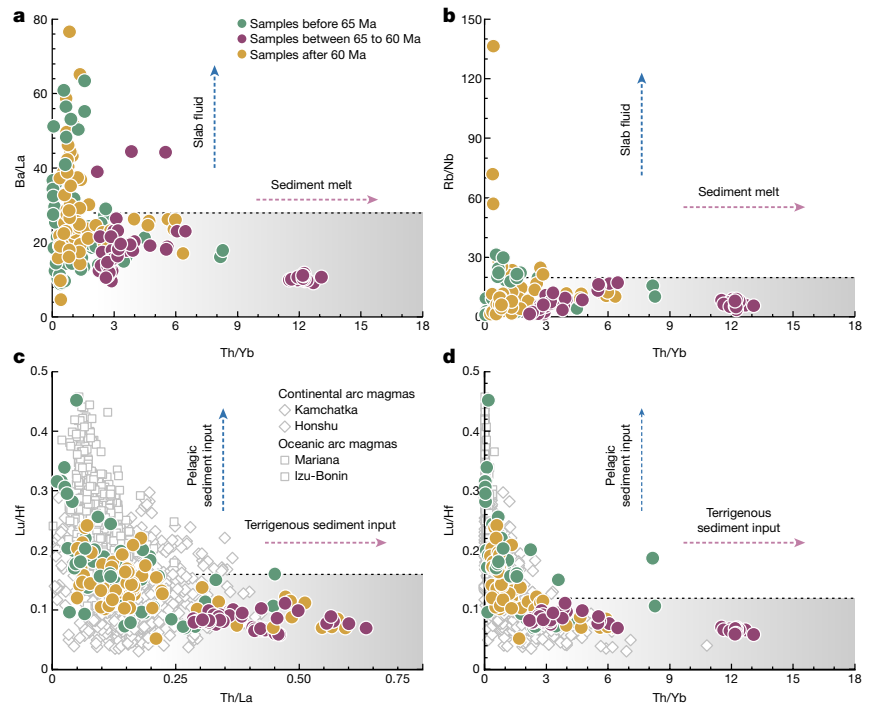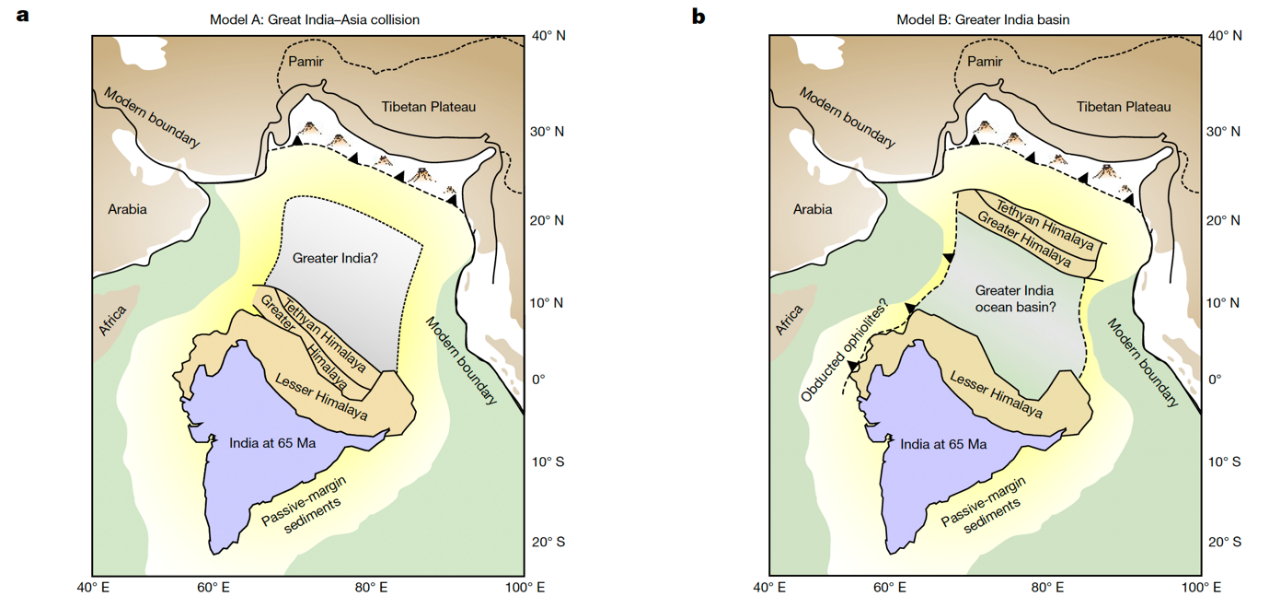During the Late Mesozoic to Early Cenozoic (~65 Ma), the convergence rate between India and Eurasia abruptly increased from ~8 cm/yr to ~18 cm/yr. This dramatic change in plate motion, known as a plate reorganization event, remains an unresolved phenomenon in plate tectonic theory (Fig. 1c). Accompanying this puzzle is the significant, decades-long debate regarding the timing and process of India-Eurasia collision, which has greatly hindered our understanding of the most significant orogenic event since the Phanerozoic—the Tibetan-Himalayan orogeny—and its impact on the paleoclimate and paleoenvironment of Asia.
Two main hypotheses have been proposed to explain the accelerated India-Eurasia convergence: the “Réunion” plume push and the double subduction in the Neo-Tethys Ocean. While these mechanisms may partially account for the increased convergence rate, debate continues surrounding the existence and the timing of the two events, and whether they can fully explain the increased convergence rate. In contrast to these earlier studies that have focused on the “distal effects” outside the ocean-continent subduction zone, recent research has begun to highlight the rheological properties of the subduction channel (or subduction interface) as a critical factor influencing subduction dynamics.
The subduction channel, typically composed of subducting oceanic crust and overlying sediments, plays a crucial role in material cycling within the subduction zone. Unlike the mafic igneous oceanic crust, subducting sediments exhibit higher pore pressures and weaker rheological properties, which effectively ‘lubricate’ the interface, reducing the coupling strength between the subducting and the overriding plates, and potentially accelerating the convergence rates.
Investigating how sediment subduction affects the India-Eurasia convergence is essential for a better understanding of plate tectonic evolution. However, geophysical methods can only observe present-day trench sediments. This limits a comprehensive understanding of the effects of sediment subduction, especially for events that occurred in the past.

Associate Professor Jiashun Hu’s research team from the Department of Earth and Space Sciences at the Southern University of Science and Technology (SUSTech) has recently collaborated with Assistant Professor Luca Dal Zilio from Nanyang Technological University, Professor Ming Tang from Peking University, and Professor Xiumian Hu from Nanjing University. Together, they adopted a novel approach, integrating geochemical analyses with geodynamic modeling to explore how passive-margin sediment subduction influenced the India-Eurasia convergence rate and the stress evolution in Tibet during the Late Cretaceous. Their research further constrains the age of the initial India-Eurasia collision to around 60 Ma.
Their paper, entitled “India-Eurasia convergence speed-up by passive-margin sediment subduction”, has been published in Nature.

Figure 1. (a) Tectonic framework of the Himalaya-Tibetan Plateau and the location of the Gangdese arc. (b) ԐNd(t) versus 87Sr/86Sr(i) diagram, showing the possible roles of Indian continental sediments (Tethys-Himalaya and High-Himalaya sediments) in the formation of mantle source of the Gangdese Late Mesozoic-Early Cenozoic magmatic rocks during magmatic evolution. (c) Variation of Sr isotope composition, convergence rate, and crustal thickness from 100 to 20 Ma.
The research team first collected geochemical data from arc magmatic rocks produced during ocean-continent subduction, selecting samples that reflect mantle source characteristics. Using trace elements and isotopic indicators, they characterized the nature and relative proportions of metasomatic agents in the mantle source (Figs. 1b, 2). Results indicate a significant increase in the relative proportion of subducted sediments within the mantle source during the period of accelerated India-Eurasia convergence (~65 Ma).
Based on Sr-Nd isotopic two-endmember mixing models, the proportion of subducted sediments in the mantle source during this period reached a value of 0.8-1.0%, primarily composed of terrigenous sediments. In contrast, before the phase of convergence acceleration, the mantle source was predominantly metasomatized by fluids from the oceanic crust, with subducted sediments comprising only 0.3-0.5% (Fig. 1b). Furthermore, the enriched isotopic characteristics of the magmatic rocks suggest that the sediments entering the subduction channel during the accelerated convergence phase were more closely related to the ancient, isotopically enriched northern Indian continental crust, rather than weathered products from the younger, isotopically depleted Gangdese batholith.
Based on observations of widespread thick sedimentary cover on oceanic crust adjacent to modern passive margins, alongside geochemical data indicating a shift in the dominant metasomatic agent from oceanic crustal fluids to terrigenous sediment melts, and the fact that oceanic plate near the northern Indian margin is colder and thicker than the portion that had already subducted beneath Eurasia (reducing sediment melting), the team suggests that the enhanced sediment melt signals in the ~65 Ma magmatic rocks are best explained by the input of thick passive-margin sediments rather than by accelerated subduction rates alone. The latter would accelerate corner flow in the mantle wedge, which brings more fertile mantle peridotite, but would not necessarily change the mixing ratio between sediment melts and the fertile mantle.
These findings indicate that the subduction of thick passive-margin sediments likely played a crucial role in the increased convergence rate during this period.

Figure 2. (a) Ba/La versus Th/Yb and (b) Rb/Nb versus Th/Yb diagrams showing the possible enriched components in the mantle source of the Late Cretaceous-Early Cenozoic magmatic rocks of the Gangdese arc. (c) Lu/Hf versus Th/La and (d) Lu/Hf versus Th/Yb diagrams showing the possible contribution of subducted sediments in the mantle source of the Late Cretaceous-Early Cenozoic magmatic rocks of the Gangdese arc.
Building on these findings, the researchers further employed high-resolution 2D numerical models to quantitatively assess how subducted sediment thickness impacts subduction velocity and stress states within the overriding plate during the India-Eurasia convergence. To test the robustness of their conclusions, they varied parameters such as sediment viscosity and pore pressure within a reasonable range.
The results closely matched historical observations of plate motion and strain in the overriding plate. The addition of subducted sediments reduced the friction coefficient and viscosity and created a ‘lubricating’ effect within the subduction channel. Consequently, sediment incorporation accelerates subduction and promotes decoupling between the subducting and the overriding plates, generating an extensional tectonic setting in the overriding plate. This is consistent with the geochemically inferred crustal thinning during this period (Fig. 1c).

Figure 3. Two scenarios proposed for the Indo-Eurasian convergence. (a) Model A: The Great Indian Continent model where the long-term, large-scale erosion of the passive margin produced large amounts of sediments whose subduction led to the acceleration of India-Eurasia convergence at 65 Ma. (b) Model B: The Great Indian Basin model, the same as in Model A, except that a pull-apart basin may have developed within the Indian continent before the subduction of the northern passive margin.
This study demonstrates that by ~65 Ma, passive-margin sediments from the Indian continent had already begun to subduct into the mantle source. Since passive-margin sediments typically span ~1000 km on the adjacent oceanic plate, which takes about 5 Ma to be consumed by subduction given the convergence rate between India and Eurasia at ~65 Ma, the initial collision between India and Eurasia is estimated to be around 60 Ma (Fig. 3). This research aligns with the Greater India model but does not rule out the possibility of a two-stage collision.
The Tethyan Himalaya may have separated from the Indian continent, forming the Greater Indian Ocean basin. Still, the spreading needs to be ceased by ~65 Ma to allow the transmission of stress from the Tethyan Himalaya to the Indian continent. This study confirms that beyond “distal effects,” the intrinsic properties of the subduction interface significantly impact subduction zone dynamics. As an important component of the subduction interface, subducting sediments may serve as a critical link between plate tectonics, climate evolution, and biosphere development.
Dr. Hao Zhou from Professor Jiashun Hu’s group is the first author of the paper, with Professor Jiashun Hu as the second and corresponding author, and SUSTech is the first affiliated institution. Other collaborators include Assistant Professor Luca Dal Zilio from Nanyang Technological University, Professor Ming Tang from Peking University, Professor Xiumian Hu from Nanjing University, and Ph.D. student Keqing Li from Professor Jiashun Hu’s group.
Paper link: https://doi.org/10.1038/s41586-024-08069-6
To read all stories about SUSTech science, subscribe to the monthly SUSTech Newsletter.
Proofread ByAdrian Cremin, Yingying XIA
Photo ByDepartment of Earth and Space Sciences